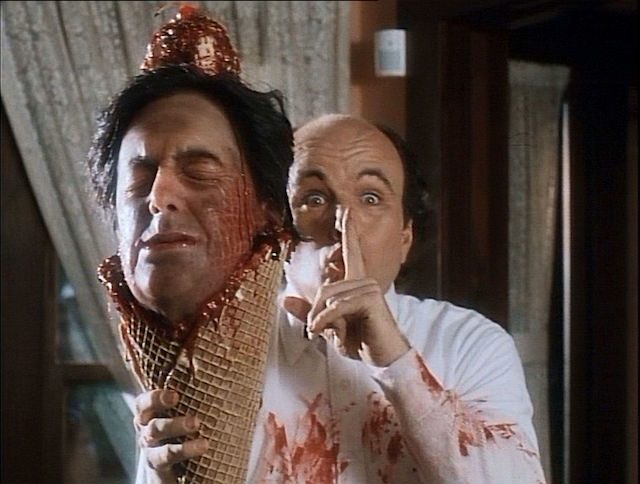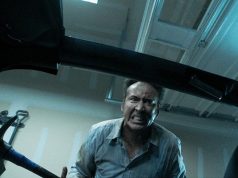
One of the ways that unimaginative people come up with ideas for horror movies is to take something normally perceived as harmless and have it start killing people. That’s why there are movies about killer Santa Clauses, Tooth Fairies, Easter Bunnies, dolls and other toys, snowmen, gingerbread men, scarecrows, tomatoes, and beds, to name too many. Few of these movies are ever popular, good, or successful, but at least they are numerous.
So it was only a matter of time before someone thought, “We should make a movie about a killer ice cream man! And the movie should be punishingly bad, even by the low standards of Movies About Killer Things! And it should star Ron Howard’s creepy-looking brother and not make any sense!” Why anyone would have these thoughts, I do not know, but the thoughts led to actions, and the actions led to the movie “Ice Cream Man,” after which no further thought was necessary, or even possible.
The premise is very simple, yet somehow still mishandled. In a black-and-white prologue, a young boy in a picturesque, Anytown U.S.A. suburb is traumatized when he sees his friendly neighborhood ice cream man murdered in a drive-by shooting. No reason is given for the shocking crime. (Territory disputes with rival ice cream vendors? Payback by militant anti-dairy vegans?) The important thing is that the boy who witnessed it, Gregory, is scarred for life. “Who’s gonna bring the ice cream?” he asks his mother forlornly, like there’s only one ice cream man in the whole world. So Gregory may not have been the most mentally competent child to begin with.
As if witnessing a murder weren’t enough trauma for one boy’s life, he grows up to be Clint Howard. He also spends years in an insane asylum, presumably because of the horror he witnessed (but possibly also because of being Clint Howard). Newly released, he becomes the ice cream man in his hometown, which has evidently gone without mobile frozen snacks services all this time. “That new ice cream man’s pretty freaky!” says one kid, accurately. “Maybe he’s just different!” replies another, giving Gregory the benefit of the doubt. Said by no one: “Why have the adults in our city allowed a defunct ice cream business to be revived by the boy who had a mental breakdown after seeing the previous owner gunned down in broad daylight?”
Gregory’s attitude toward being an ice cream man is complicated. On the one hand, he views it as a solemn duty to drive a van around the neighborhood on hot summer days, bringing joy and refreshment to all the boys and girls. But on the other hand, the inside of the van is lousy with mice and cockroaches, he uses his bare hands to scoop an ice cream cone, and he kills a neighbor’s dog and puts one of its eyes in somebody’s rocky road. You would expect this kind of contemptuous behavior from a Taco Bell employee or Newt Gingrich, but from the ice cream man? Disappointing.
One night Gregory abducts a neighborhood boy named Paul and stuffs him into the back of the ice cream van. Witnessing the act is Paul’s friend Tuna, a chubby boy whose odd name is not explained, and whose “chubbiness” is obviously the result of making the young actor wear bulky, padded sweaters all the time, even though the movie takes place in the summer.
You’re thinking that if they went to the trouble of making a non-chubby boy look chubby, it must be crucial to the plot for this character to be overweight. That’s certainly what I was thinking! But it turns out we are both wrong: Tuna’s weight is only referenced a couple times and never plays a part in the story. It is genuinely baffling.
Anyway, Tuna tells the cops what he saw, and the cops — played by Jan-Michael Vincent and Lee Majors II — search Gregory’s ice cream factory and warehouse. They do not, however, look in the van, which is the one place where Tuna specifically told them he saw Paul. My point is, everyone in town is a moron. My other point (I have two points) is that Lee Majors had a son named Lee Majors II.
And where is Paul? Oh, he’s fine. Gregory has him in a hidden room — not only did the cops fail to search the place where Paul was last seen, they also did an incomplete job of searching the place they did search — and is teaching him to be his apprentice. “Ice Cream Man” is set in a world where the men who drive ice cream trucks don’t just sell Eskimo Pies and Fudgsicles, they also sell their own fresh-scooped ice cream, which they make themselves back at the warehouse. Confectioners, drivers, sales clerks, business owners — they’re really Renaissance men, these ice cream men. Gregory is passing this knowledge on to Paul, who doesn’t seem to mind having been abducted and never tries to escape, making him the ideal hostage.
Perhaps you are troubled, as was I at this point, by the film’s lack of child murders. To be clear, I do not endorse the murder of children in real life (generally). But in a movie that promises a homicidal ice cream man, it is only natural to assume that children will be among his victims. Why give him a kid-oriented profession if he’s only going to kill adults? Yet so far Gregory has only dispatched a dog (which is not a child) and an old man (which is literally the opposite of a child). And we didn’t even get to see him kill the old man! (We don’t know why he did it, either. The grandfatherly fellow’s only scene had him appearing in a public park to tell children the story of “The Pied Piper,” which the movie seems to think is relevant to its own story. Which means the people who made “Ice Cream Man” either never read “The Pied Piper” or, just as likely, did not know what “Ice Cream Man” was about.)
To compensate for his failures in the child-murdering department, Gregory kills a few grown-ups, including Tuna’s philandering father and his mistress. He also decapitates two uniformed police officers and does a puppet show with their heads. I must admit that the fake heads look pretty good for a movie that couldn’t even afford to hire a real fat kid to play the fat kid. The filmmakers knew they looked good, too, and sought to get their money’s worth by giving them 10,000 minutes of screen time.
Meanwhile, Gregory halfheartedly terrorizes Tuna and his pals Jimmy and Heather, who ride around on bicycles and like to think of themselves as junior sleuths. Heather’s father (played by notable character actor David Warner) is the town’s minister, and in one scene Heather’s mother is shown speaking in tongues — “the archangel Gabriel speaking through her,” according to her husband. This intriguing bit of information is never mentioned again and plays no role in the story. Was it part of an excised subplot? Or was the movie vainly struggling to change itself into a different movie?
Gregory’s ice cream van says “WATCH OUT FOR CHILDREN” on the back … except in some shots, where the word “FOR” has been painted over. At first I thought this was a subtle joke, that the van would say “WATCH OUT CHILDREN” whenever Gregory was prowling for victims and “WATCH OUT FOR CHILDREN” when he was being normal. But no, it changes at random. I was giving the movie too much credit when I assumed that its obvious, flagrant, easily remedied continuity errors were there by design. I might be giving the movie too much credit when I call it a “movie.”
— Film.com





